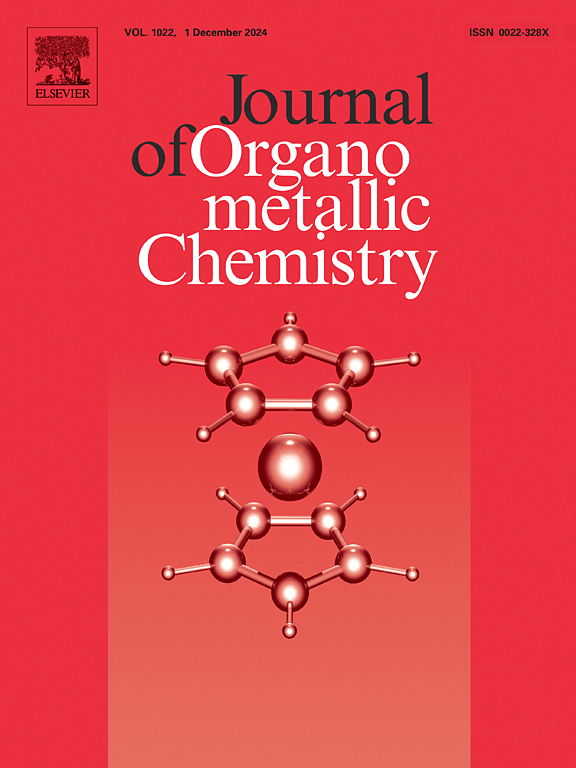Synthesis, characterization, X-ray structures, and catalytic activity of new Mn(I) and Re(I) metal complexes of chelating phosphinopyridylamine and its sulfide ligands
IF 2.1
3区 化学
Q3 CHEMISTRY, INORGANIC & NUCLEAR
引用次数: 0
Abstract
The reaction of 4-Me-C5H3N-2-NH(PPh2) (1) with Mn(CO)5Br in refluxing chloroform produced the fac-[Mn(CO)3Br{1-κ2P,N}] (2) and [Mn(CO)2{1-κ2P,N}2]Br (3) complexes. Furthermore, the refluxing of the monooxidized thioyl (4-CH3)C6H3N-2-NH(P(S)Ph2) (4) ligand with M(CO)5Br (M = Mn, Re) in chloroform yielded the fac-[M(CO)3Br{4-κ2S,Npy}] (M = Mn (5), Re(6)) complexes. The investigation of complexes 2, 3, 5, and 6 was carried out with the use of multinuclear NMR (1H, 13C and 31P NMR), infrared spectroscopy, and the determination of crystal structures. Complexes 5 and 6 represent the inaugural structurally characterized instances of this category of chalcogenide ligands associated with Mn and Re metals documented thus far. Complexes 5 and 6 demonstrate significant catalytic efficacy in the hydrogenation of acetophenone derivatives to yield 1-phenylethanol derivatives, utilizing 2-propanol as a hydrogen source.

螯合膦吡啶胺及其硫化物配体的新型Mn(I)和Re(I)金属配合物的合成、表征、x射线结构和催化活性
4- me - c5h3n -2- nh2 (PPh2)(1)与Mn(CO)5Br在回流氯仿中反应生成了面-[Mn(CO)3Br{1-κ 2p,N}](2)和[Mn(CO)2{1-κ 2p,N}2]Br(3)配合物。此外,单氧化硫基(4- ch3) c6h3n -2- nh2 (P(S)Ph2)(4)配体与M(CO)5Br (M = Mn, Re)在氯仿中回流得到了面[M(CO)3Br{4-κ 2s,Npy}] (M = Mn (5), Re(6))配合物。配合物2、3、5和6采用多核磁共振(1H、13C和31P NMR)、红外光谱和晶体结构测定进行了研究。配合物5和6代表了迄今为止记录的与锰和稀土金属相关的硫系配体的首个结构特征实例。配合物5和6在利用2-丙醇作为氢源的苯乙酮衍生物加氢生成1-苯乙醇衍生物中表现出显著的催化作用。
本文章由计算机程序翻译,如有差异,请以英文原文为准。
求助全文
约1分钟内获得全文
求助全文
来源期刊

Journal of Organometallic Chemistry
化学-无机化学与核化学
CiteScore
4.40
自引率
8.70%
发文量
221
审稿时长
36 days
期刊介绍:
The Journal of Organometallic Chemistry targets original papers dealing with theoretical aspects, structural chemistry, synthesis, physical and chemical properties (including reaction mechanisms), and practical applications of organometallic compounds.
Organometallic compounds are defined as compounds that contain metal - carbon bonds. The term metal includes all alkali and alkaline earth metals, all transition metals and the lanthanides and actinides in the Periodic Table. Metalloids including the elements in Group 13 and the heavier members of the Groups 14 - 16 are also included. The term chemistry includes syntheses, characterizations and reaction chemistry of all such compounds. Research reports based on use of organometallic complexes in bioorganometallic chemistry, medicine, material sciences, homogeneous catalysis and energy conversion are also welcome.
The scope of the journal has been enlarged to encompass important research on organometallic complexes in bioorganometallic chemistry and material sciences, and of heavier main group elements in organometallic chemistry. The journal also publishes review articles, short communications and notes.
 求助内容:
求助内容: 应助结果提醒方式:
应助结果提醒方式:


